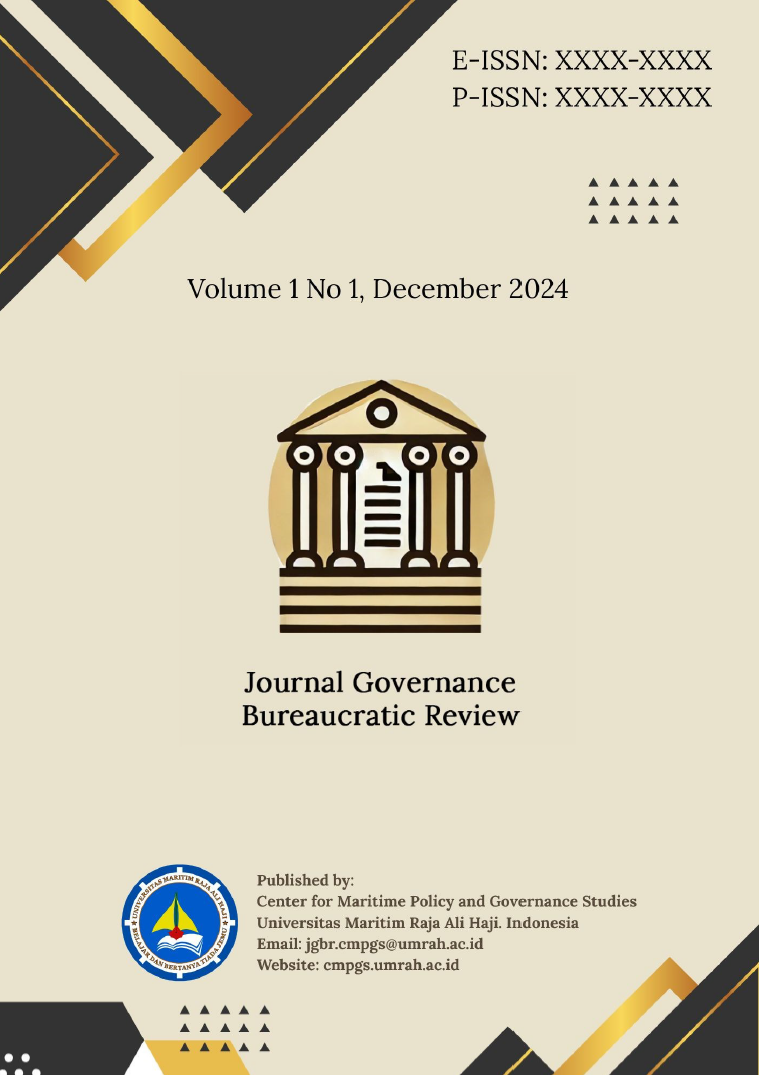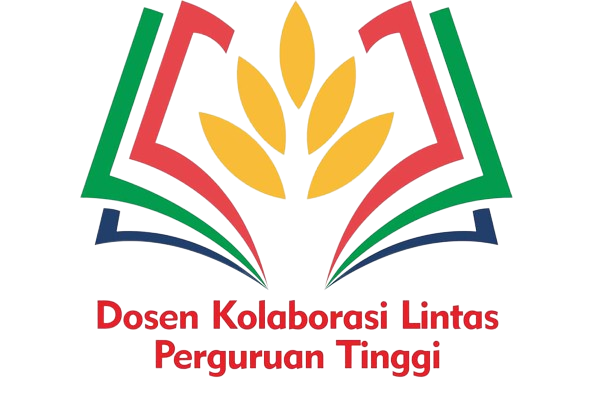Bureaucratic Reform and Economic Growth: The Case of Bintan Regency's Development Strategy
DOI:
https://doi.org/10.31629/jgbr.v1i1.7133Keywords:
Bureaucratic Reform, Economic Growth, Public Service EfficiencyAbstract
Bureaucratic reform is a critical driver of economic growth, especially in decentralized regions where local governance quality directly affects development outcomes. This study investigates the impact of bureaucratic reform on the economic performance of Bintan Regency, Indonesia. Using a qualitative case study approach that includes document analysis and systematic literature review, the research explores how administrative modernization contributes to improved service delivery, investment facilitation, and institutional efficiency. Findings reveal that reform initiatives particularly digital licensing systems, streamlined bureaucratic processes, and enhanced inter-agency coordination have significantly supported economic growth. In 2023, Bintan recorded a 6.14% GRDP growth, with the manufacturing sector contributing 40.25% and capital formation accounting for 59.99% of the growth from the expenditure side. These outcomes align with meta-analytic evidence that highlights the positive effects of bureaucratic transparency and performance-based governance on regional development. However, challenges such as political clientelism and institutional fragmentation remain barriers to sustained reform. The study concludes that while Bintan's reforms have yielded tangible economic benefits, long-term success depends on embedding reform into legal and operational structures, ensuring resilience against political disruptions. This case provides practical insights for policymakers seeking to align governance innovation with inclusive economic development. The research highlights the importance of adaptive bureaucratic structures in achieving inclusive economic growth, suggesting that Bintan’s experience can serve as a model for other regions facing similar governance challenges.
Downloads
References
Berenschot, W. (2018). Incumbent bureaucrats: Why elections undermine civil service reform in Indonesia. Public Administration and Development, 38(4), 135–143. https://doi.org/10.1002/PAD.1838
Bowen, G. A. (2009). Document analysis as a qualitative research method. Qualitative Research Journal, 9(2), 27–40. https://doi.org/10.3316/QRJ0902027/FULL/XML
Braun, V., & Clarke, V. (2006). Using thematic analysis in psychology. Qualitative Research in Psychology, 3(2), 77–101. https://doi.org/10.1191/1478088706QP063OA
Brewer, G. A. (2004). Does Administrative Reform Improve Bureaucratic Performance? A Crosscountry Empirical Analysis. Public Finance and Management, 4(3), 399–428. https://doi.org/10.1177/152397210400400306
Britan, G. (1979). Evaluating a Federal Experiment in Bureaucratic Reform. Human Organization, 38(3), 319–324. https://doi.org/10.17730/HUMO.38.3.MG042530M792867R
Cruz, C., & Keefer, P. (2015). Political Parties, Clientelism, and Bureaucratic Reform. Comparative Political Studies, 48(14), 1942–1973. https://doi.org/10.1177/0010414015594627
Dhaliwal, I., & Hanna, R. (2017). The devil is in the details: The successes and limitations of bureaucratic reform in India. Journal of Development Economics, 124, 1–21. https://doi.org/10.1016/J.JDEVECO.2016.08.008
Fountain, J. E. (2008). Bureaucratic reform and e-government in the United States: An institutional perspective. In Routledge Handbook of Internet Politics (pp. 99–113). Taylor and Francis. https://doi.org/10.4324/9780203962541-9/BUREAUCRATIC-REFORM-GOVERNMENT-UNITED-STATES-JANE-FOUNTAIN
Gedeona, H. T., & Trilestari, E. W. (2021). The Model for Implementing Bureaucratic Reform in the Ministry of Administrative Reform. Proceedings of the 2nd International Conference on Administration Science 2020 (ICAS 2020), 564, 146–155. https://doi.org/10.2991/ASSEHR.K.210629.028
Given, L. M. (2008). The SAGE Encyclopedia of Qualitative Research Methods. SAGE Publications.
Hidayat, F. (2023). The Impact Of Bureaucratic Reform On Indonesian Governance: A Perspective Review of Academic Literature. Jurnal Politik Pemerintahan Dharma Praja, 16(2), 169–196. https://doi.org/10.33701/jppdp.v16i2.3761
Labolo, M., & Indrayani, E. (2017). Bureaucratic Reform and the Challenge of Good Governance Implementation in Indonesia. Journal Of Asian Review Of Public Affair And Policy, 2(4), 25–47.
Laking, R. (1999). Don’t try this at home? A New Zealand approach to public management reform in Mongolia. International Public Management Journal, 2(2), 217–235. https://doi.org/10.1016/S1096-7494(00)89036-4
Lee, H. Y. (1984). Evaluation of China’s Bureaucratic Reforms. The ANNALS of the American Academy of Political and Social Science, 476(1), 35–47. https://doi.org/10.1177/0002716284476001004
Maulana, A., Indriati, F., & Hidayah, K. (2022). Analysis of Bureaucratic Reform Through Delayering of Government Institutions in Indonesia. Jurnal Borneo Administrator, 18(2), 155–170. https://doi.org/10.24258/JBA.V18I2.1003
Paskarina, C. (2017). The making of competitive bureaucracy: A case of bureaucratic reform in West Java province. Cogent Social Sciences, 3(1), 1273748. https://doi.org/10.1080/23311886.2016.1273748
Warsono, H., Hanani, R., & Putra, H. D. (2020). Collaborative governance framework in health care: A qualitative exploration of hospital pharmacy management reform at hospital setting in Indonesia. Systematic Reviews in Pharmacy, 11(4), 337–341. https://doi.org/10.31838/SRP.2020.4.49
Wihantoro, Y., Lowe, A., Cooper, S., & Manochin, M. (2015). Bureaucratic reform in post-Asian Crisis Indonesia: The Directorate General of Tax. Critical Perspectives on Accounting, 31, 44–63. https://doi.org/10.1016/J.CPA.2015.04.002
Winoto, S., Akbariah, L., Yulitasari, L. D., Natasha, C. E., Kumalasari, I., & Yin, T. P. (2024). Implementation of Thematic Bureaucratic Reform: Level of Understanding and Realization in Local Government. Journal Governance Society , 1(1), 27–37. https://doi.org/10.69812/JGS.V1I1.32
Yin, R. K. (2018). Case Study Research and Applications Design and Methods Sixth Edition. In Japan Marketing Journal (6th ed., Issue 2). SAGE Publication.
Yusriadi, Y., Akib, H., & Ihsan, A. (2017). Bureaucratic Reform in Public Service: A Case Study on the One Stop-Integrated Service. Mediterranean Journal of Social Sciences, 8(2), 253–258. https://www.richtmann.org/journal/index.php/mjss/article/view/9884
Yustia, D. A., & Arifin, F. (2023). Bureaucratic reform as an effort to prevent corruption in Indonesia. Cogent Social Sciences, 9(1). https://doi.org/10.1080/23311886.2023.2166196
Zhang, Z., Wang, J., Feng, C., & Chen, X. (2023). Do pilot zones for green finance reform and innovation promote energy savings? Evidence from China. Energy Economics, 124. https://doi.org/10.1016/j.eneco.2023.106763
Downloads
Published
Issue
Section
License
Copyright (c) 2024 baniyah Ibaniyah, Irma Metyana, Ranti Marshanda Sintiana, Sri Kesuma Dewi, Syafiq Ramadan

This work is licensed under a Creative Commons Attribution-ShareAlike 4.0 International License.
You are free to:
- Share — copy and redistribute the material in any medium or format for any purpose, even commercially.
- Adapt — remix, transform, and build upon the material for any purpose, even commercially.
- The licensor cannot revoke these freedoms as long as you follow the license terms.
Under the following terms:
- Attribution — You must give appropriate credit, provide a link to the license, and indicate if changes were made . You may do so in any reasonable manner, but not in any way that suggests the licensor endorses you or your use.
- ShareAlike — If you remix, transform, or build upon the material, you must distribute your contributions under the same license as the original.
- No additional restrictions — You may not apply legal terms or technological measures that legally restrict others from doing anything the license permits.













